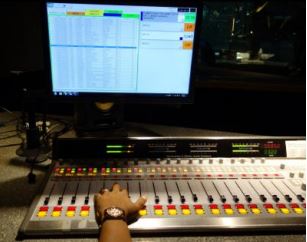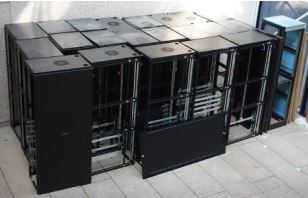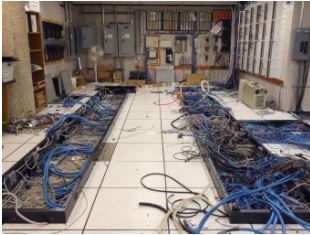A Radio Showcase Built, Then Unbuilt Part 2

[July 2017] It was June 2015. Margaret Bryant has been contracted to empty some 250,000 square feet of studios, offices, and technical gear before the end of the month – and shut down a facility she had designed and built 20 years before. Here is how it turned out.
I was there for the design and construction of the ABC Radio Networks facility on Montfort Drive in Dallas during 1994-1995 – and I was there for the total decommissioning of the site in 2015.
This is the conclusion of the story of one of America’s biggest studio and satellite transmission complexes.
Clearing Out
Pretty much everything had to go.
And all of this was to be accomplished in a few weeks’ time, with only four people. In the very end, though, it was just me and Jody McJunkins, the building manager.
Whew!
Clear the House
Cumulus wanted to keep some of the studio equipment, some of the TOC equipment, and a little bit of the office equipment.
It was up to me to figure out how to get rid of everything else: including 120+ offices full of furniture, 36 studios of consoles and studio furniture, everything in the TOC including the racks, everything in the engineering shop, the Nortel phone switch, everything in the basement, and every inch of audio and control wire that was in the raised floor, the ceiling, the walls, and the rooms.
Just reciting that can make one tired. We had to move all of that out – and on time!
Fortunately a couple of the biggest items, the generator and the large studio UPS, could stay. However the IT server room UPS had to go.
Sorting Through the Building
To expedite things, we set up staging areas for the various items being removed.
For example, the Third Floor East conference room had stacks of equipment that was being saved and repurposed. (Most of it was analog, but was still useful.)
The First Floor West conference room was the recycle room. Here we stacked hundreds of computers to be shredded, along with other IT equipment, antiquated radio equipment, some wire, and assorted pieces of metal. The recycler came in about once a week to remove all of the items in the room.
The big open areas on the First and Third Floors West where the cube farms had been became staging areas for office furniture. Later a cube area on the Second Floor West (Radio Disney) was also pressed into service as a furniture staging area.
Turning Out the Drawers
Jody started by cleaning out the desks in all 120+ offices.
A large first floor West office became the office supply “store.” The items were organized by type: big plastic mail bins held the sorted items, including dozens of staplers, dry erase markers, pens, sticky note pads, pencils, scissors, and and so on.
The office furniture was tagged as to availability. Most all of it was available. Very little was being repurposed in the TM Century building (the “new” Dallas site for remaining operations).
Non-Profit Gold Mine
A fun part of the job was for Jody or I to give the local non-profit organizations a “tour” through the floors.
It was like shopping in a furniture store where everything was free!
The non-profit would go through and tag the furniture items they wanted, then send a truck with people to retrieve them.

Office furniture staged for pickup
Every few days a non-profit would stop by and clean out the office supplies. Nevertheless, before the week was out, the bins would be full again. This went on for several weeks.
After a while I was getting to be quite the sales person. When the non-profit people discussed their needs, I would make suggestions about other furniture that might also fulfill their needs. My goal, of course, was to get them to cart off as much furniture as they would take off my hands.
Consoles, Tables, Everything!
While the furniture purge was going on, we were also cleaning out the studios that were no longer being used.
Several of the studios already had most of the ancillary equipment removed.
All that remained in those studios were the PR&E custom studio furniture, the PR&E audio console (usually a Radiomixer), a PR&E power supply for the console, a bookcase, and some blank rack panels.
Engineers from other Cumulus stations came in to take the PR&E studio furniture and PR&E audio consoles from a few of the studios.
While they were there with their trucks, I would take them up to the Third Floor East conference room to go “shopping” in the staging room teeming with analog equipment. That was a room I loved to take engineers to see.
I would unlock the door and turn on the lights, and watch their eyes get wide as they surveyed the stacks and stacks of KRK speakers, Gentner/ Comrex phone hybrids, assorted microphone processors, headphone amps, Tascam cassette machines, Denon CD players, distribution amplifiers, Telos Zephyrs, CD recorders, and even more to choose from.
Winner Takes it All!
Once the Cumulus engineers took what they wanted, I needed to get rid of the remaining studio furniture and consoles.
The furniture was huge and the consoles were 20 years old and analog. Yet we still had people who were interested. But I needed to insure that. if someone was interested in the studio furniture and consoles, they took everything in the room, even the items they did not want. When someone was interested in studio furniture and a console, the agreement was that they had to clean out the entire room.
I really did not care if they put the furniture in the dumpster in the back of the building. I just needed the room to be clean.
Special Insurance
To insure that people followed through with their promises, I removed the console power supplies from each room and held them hostage.
If they wanted the power supply and manual for the console, the studio had to be “broom clean.”
Yes, I inspected each room before turning over the power supply and the manual! With only four of us decommissioning the building, the more work we could have others do, the better!
This worked really, really well. You might say that this was an extreme measure, but it was necessary. Early on we had someone leave with an audio console and a promise to return for the furniture and a studio clean up. You can guess what happened!
After my new policy, we never had the problem again.
Disconnection

While the Second Floor East studios were being emptied, the contractor Cumulus hired was removing the five stationary 3.8 meter satellite dishes from the roof. When the crane was brought in to lower the dish pieces over the side of the building it was sad.
A week or so later when they were dismantling the 4.5 meter movable uplink dishes on the top floor of the parking garage, it really hit me that it was all over. (Video here)

Just a Few Items Left
Nevertheless, by now it was becoming quite clear that no matter how much progress we were making, it just was not possible for us to be done by the end of June. There was just too much yet to be done.
Fortunately, Cumulus negotiated a one month extension with the owner which would give us the time to clean out the areas occupied by Radio Disney that were only now about to be vacated.
Once the Second Floor East studios were emptied of furniture and equipment, we could start pulling up the raised floor and remove the miles and miles of audio and control wire that was there.
 We had another contractor that Cumulus had engaged to do this task.
We had another contractor that Cumulus had engaged to do this task.
I asked the supervisor how long he thought it would take to remove all of the wire. He said “about a week.” I told him I thought he was being optimistic. He launched into a lecture about how he had been doing this for years and he knew what he was doing. He continued “mansplaining” about what needed to be done, and how he knew how to get it done.
It was not until he was two weeks into his “one week” project that he conceded he owed me an apology. There was a lot more wire in the floor than he thought.
I responded that I was not at all surprised, as my staff and I had put it there!
Piles and Piles of Wire
The atrium was the staging area for the wire that was removed.

Jody sitting atop one of several wire piles
Like I said, miles of wire were removed and sorted by type. We had enormous piles of 26- pair Gepco audio wire in the atrium. We would have a pile removed and taken to the recycler only to have another, even larger pile take its place two days later.
Fade to Silence
After several weeks it was finally time to end all broadcasting from the building and move the remaining two shows to the TM Century building.
Doug Banks went first. Then it was down to the D.L. Hughley Show.
On the last day of broadcasting from the Montfort building, D.L. Hughley was airing a “best of” show. I videoed the last on-air fader in the building being pulled down to silence. (Video)

In TOC, I videoed engineer Clark Tucker turning off the last of the T-1 equipment sending the show offsite to the satellite uplink. It was fit-ting that Clark turned off the last of the transmission equipment because he had been with the network since the 1980s.
For you trivia buffs, the last song to leave the building was “What You Won’t Do for Love” by Go West.
Final Breakdown
Once the last of the shows stopped originating from the building we could finally remove the last of the equipment from the TOC.
We had someone who was willing to take all of the 40+ equipment racks off our hands, so they all got pulled the same day … staged in the atrium .

TOC sans all the gear

The TOC was now an empty room of raised floor with rows of openings in the floor where the racks once stood.
It was like running a film backwards in slow motion. All the work we did 20+ years ago to build the facility was now almost completely undone.

This is an ex-TOC
At the beginning of the project, Jody had placed a floorplan drawing on the wall outside my office. On it we colored in spaces with a highlighter marker to show which rooms were totally empty.

As you can see, by now the Third Floor was now almost totally colored in. Most of the Second floor was also colored in.
We kept a few offices on the First Floor and the Third Floor Conference Room for temporary equipment storage. Otherwise the First Floor was also mostly colored in.
Last Bits
We were down to finishing out the basement, a few things in TOC, the engineering shop and odds and ends of furniture.
The Nortel phone switch in the basement was removed by the recycler. The recycler also took the UPS out of the IT server room.
I found someone to take away the remaining First Floor East studio furniture and consoles.
Toward the end of the project we had started leaving the few pieces that remained of the 120+ offices of furniture, outside by the back door in hopes that some of the dumpster scavengers would take them.
A few of them did.
Closing Down the Project
By the end of the third week in July, it was time for me to say my goodbye to the building.
I had to leave. I had been working on this project for seven weeks and I had to get back to my photography business. The project was not quite finished, but we were 99% there.
By now, almost all of the rooms on the floorplan were now colored in. Movers had been scheduled to move all of the saved equipment to storage.
The project had been bittersweet. It was sad in the beginning. Then I just wanted to get it over with. At the very end it was sad again.
Final Goodbye’s
During my time that summer, many former employees stopped by.
It was wonderful to see former co-workers that I had not seen in many years. My time there also helped me to decide what I want to be in my next life: a philanthropist. I really did enjoy giving things away!
I also documented the decommissioning with photos (some of which you see here – and in the first article) and videos, and I intend to put together a longer video of my time there at some point.
Lasting Final Memories
Before the building was turned over to the owners, Jody and I had one final thing to do: remove the pictures.
Over the many years in the building we had had a few employees who we honored with their photo on a plaque in the lobby. The tradition started with the passing of Bob Morgan, the security guard. He died of old age. Beloved by all, we wanted to remember him. It is said that people still felt his presence after he was physically gone.
As the years went by, we lost other employees to illness and death. We wanted to remember them too. Jody and I thought the photo plaques should stay with the building to honor the people who had given so much of themselves to the network.
Once we decided where we were going to hide them, we did our own little ceremony, each of us speaking remembrances, and tucking the plaques away in a safe place.
We hid them well. They will probably remain with the building unseen until that day sometime in the future when the building is demolished. Just a little reminder of what the building once was and the people who loved to work there.
In its day the ABC Radio Networks facility on Montfort Drive in Dallas was the largest radio facility in the country. It has now been eclipsed by many other larger radio facilities, but none will eclipse the fun we had, the music we made, the performers we hosted, the ABC family we created, and the memories we keep.
The facility we built may be gone, but the memories live on.
– – –
Margaret Bryant is a veteran of 30 years in the broadcast trenches, among the first women to be chief engineer at a Clear Channel station (WMAQ, Chicago), and a pretty darn good photographer, specializing in dog portraits (see them here). Contact Margaret at: maggiesdogs@earthlink.net
